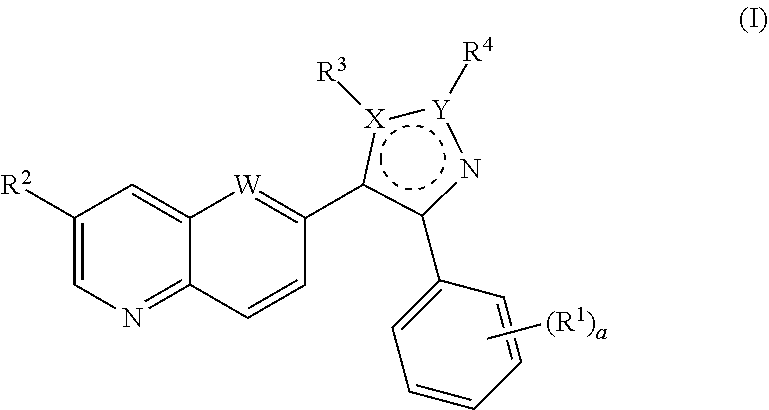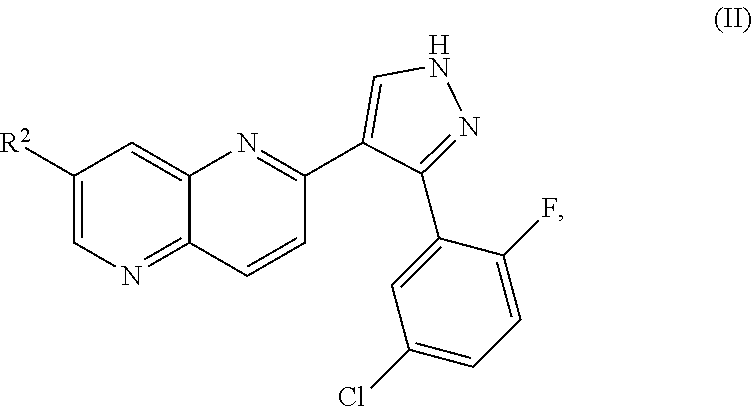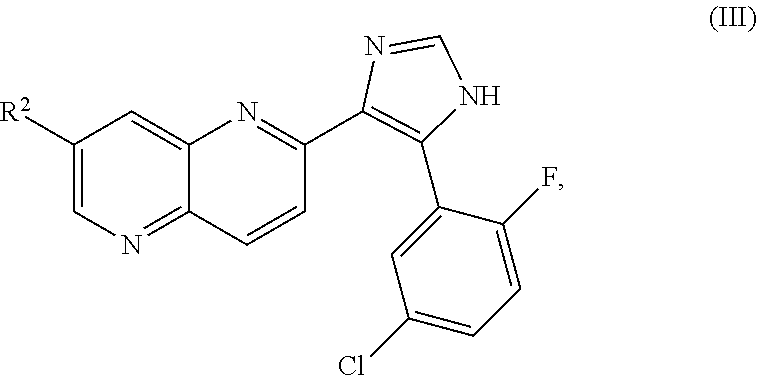ALK5 inhibitors
a technology of alk5 and inhibitors, applied in the field of alk5 inhibitors, to achieve the effect of limiting adverse side effects
- Summary
- Abstract
- Description
- Claims
- Application Information
AI Technical Summary
Benefits of technology
Problems solved by technology
Method used
Image
Examples
example 1
of 7-bromo-2-methyl-1,5-napthyridine (1)
[0546]
[0547](E)-but-2-enal (30.66 g, 437 mmol) in toluene (90 mL) was added dropwise to 5-bromopyridin-3-amine (18.0 g, 104.0 mmol) in HCl (1.8 L, 6 M) at 100° C. and the mixture was stirred for 1 h at 100° C. A further amount of (E)-but-2-enal (30.66 g, 437 mmol) in toluene (90 mL) was added in one portion and the mixture was stirred at 100° C. for another 4 h. The solvent was removed in vacuum to dryness and the pH of the residue was adjusted to pH 8.0 with NaHCO3 solid. This procedure was repeated four times and the crude products were combined and purified by column chromatography (PE:EA=100:1 to 5:1) to yield title compound 1 as a yellow solid (71 g, 95% purity, 15.3% yield). [M+H]+ calcd for C9H8BrN2 222.99, found 222.9. 1H NMR (400 MHz, CDCl3) δ 8.89 (d, J=1.6 Hz, 1H), 8.46 (d, J=1.6 Hz, 1H), 8.23 (d, J=8.8 Hz, 1H), 7.50 (d, J=8.4 Hz, 1H), 2.76 (s, 3H).
example 2
of tert-butyl 5-bromo-2,3-dihydro-1H-imidazo[1,2-a]imidazole-1-carboxylate (4)
[0548]
[0549]Step 1: To a cooled to 0° C. stirring solution of compound 2 (10.0 g, 91.6 mmol), triethylamine (9.00 g, 88.9 mmol), and DMAP (0.500 g, 4.09 mmol) in chloroform (200 mL), Boc2O (20.0 g, 91.6 mmol) was added dropwise over 30 min and the reaction mass was stirred for 16 h at rt. Then, the volatiles were evaporated and the crude product was subjected to silica gel column chromatography (hexane / MTBE) to give 19.2 g (91.8 mmol, 90%) of compound 3.
[0550]Step 2: To a solution of compound 3 (10.0 g, 47.8 mmol) in THF (200 mL) 2M solution of LDA in THF (48 mL) was added at −80° C. In 1 h dibromotetrafluoroethane (24.5 g, 94.3 mmol) was added dropwise at the same temperature. In 15 min the reaction mixture was poured into brine (300 mL) and immediately extracted with MTBE (300 mL). The solvent was evaporated and the residue was purified by the column chromatography (chloroform / hexane) to give 4.00 g (13....
example 3
of tert-butyl 7-iodo-2,3-dihydro-1H-imidazo[1,5-a]imidazole-1-carboxylate (7)
[0551]
[0552]Step 1: To a suspension of NaH (2.75 g, 68.8 mmol) in DMF (50 mL) a solution of 4,5-diiodo-1H-imidazole 5 (20.0 g, 62.5 mmol) in DMF (400 mL) was added dropwise and the resulting mixture was stirred until the gas evolution ceased. Then, a solution of 1-[(tert-butoxycarbonyl)amino]-2-chloroethane (11.2 g, 62.5 mmol) in DMF (100 mL) was added and the reaction mass was left to stir overnight at rt. The resulting mixture was concentrated to ½ of the initial volume and poured onto crushed ice. The precipitated solid was collected by filtration and dried to obtain 24.6 g (53.1 mmol, 85%) of compound 6.
[0553]Step 2: A solution of compound 6 (11.6 g, 25.0 mmol) in acetonitrile (100 mL) was stirred for 15 min at 40° C. under flow of argon. Then, K2CO3 (6.91 g, 50.0 mmol), CuI (0.714 g, 3.75 mmol), and DMEDA (0.556 g, 6.31 mmol) were added and the reaction mass was maintained at 80° C. for 21 h. The insol...
PUM
 Login to View More
Login to View More Abstract
Description
Claims
Application Information
 Login to View More
Login to View More - R&D
- Intellectual Property
- Life Sciences
- Materials
- Tech Scout
- Unparalleled Data Quality
- Higher Quality Content
- 60% Fewer Hallucinations
Browse by: Latest US Patents, China's latest patents, Technical Efficacy Thesaurus, Application Domain, Technology Topic, Popular Technical Reports.
© 2025 PatSnap. All rights reserved.Legal|Privacy policy|Modern Slavery Act Transparency Statement|Sitemap|About US| Contact US: help@patsnap.com



